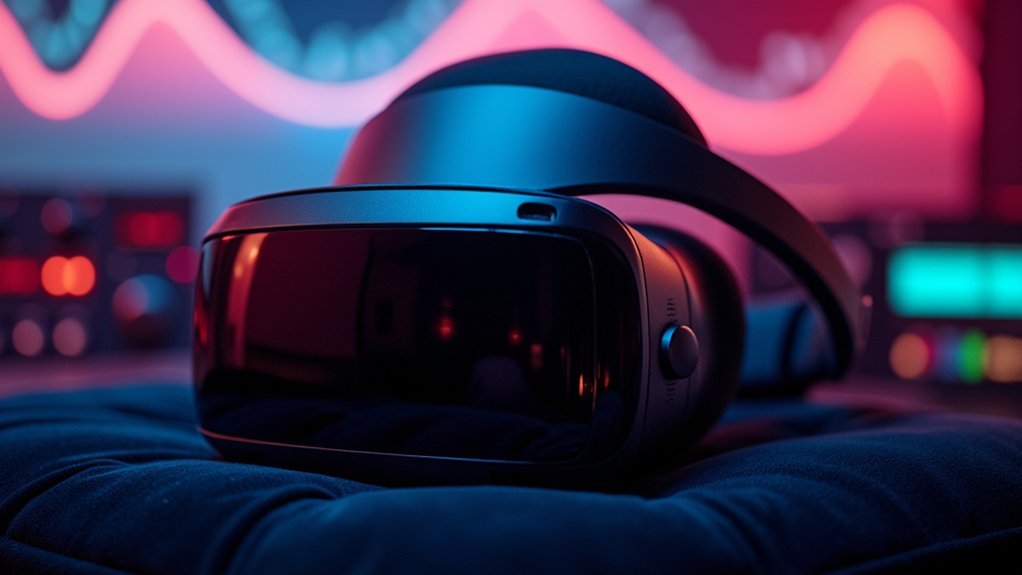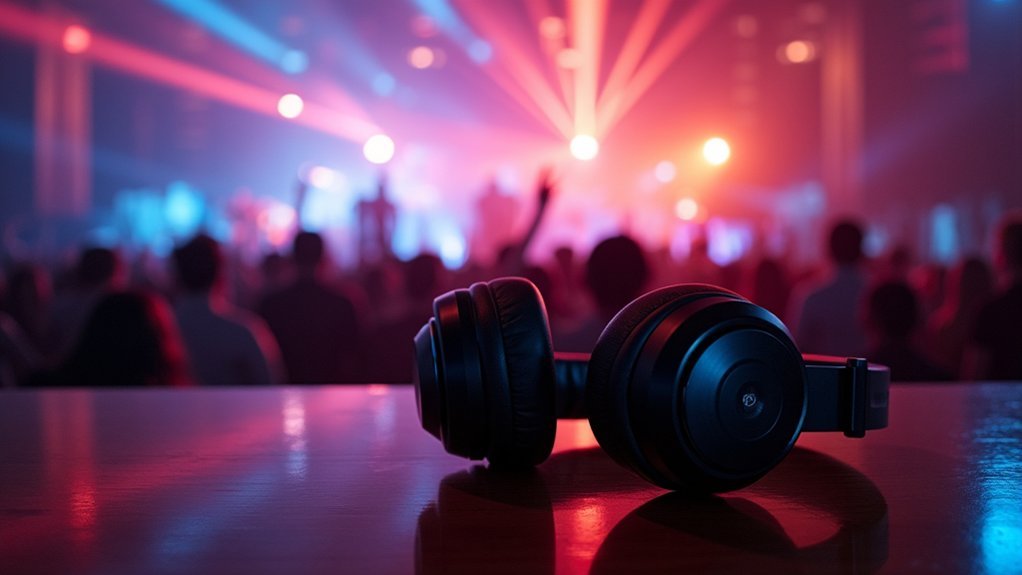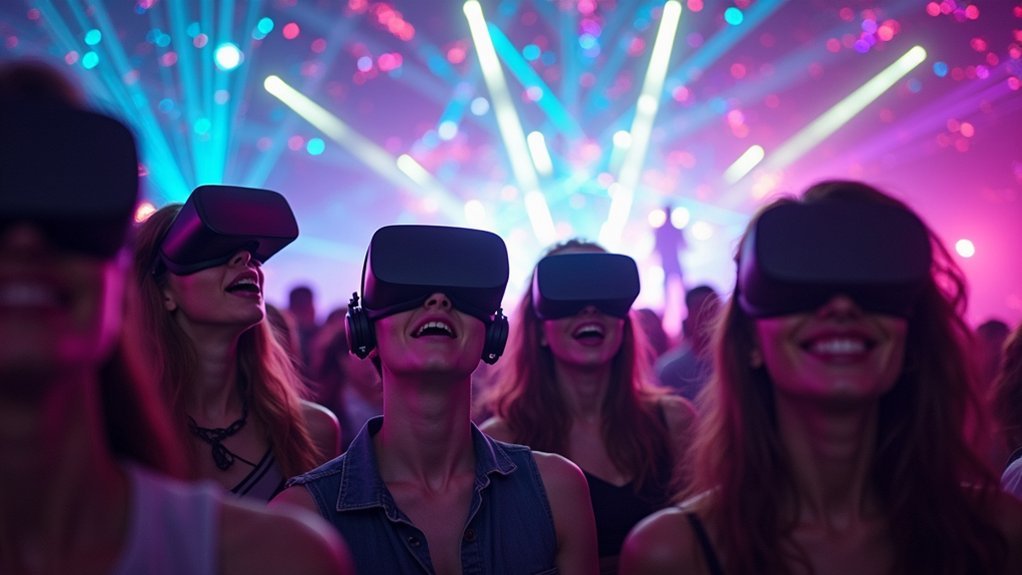VR concert audio feels incredibly real because it uses spatial audio technology that mimics how your ears naturally process sound in three-dimensional space. Your headset employs Head-Related Transfer Functions (HRTFs) and binaural processing to create precise sound localization, making you hear instruments and vocals from specific directions and distances. The technology adapts to your head movements in real-time, maintaining accurate audio positioning that tricks your brain into believing you’re actually at a live concert. The science behind this immersive experience reveals fascinating details about how technology transforms entertainment.
The Science Behind Spatial Audio Technology

When you put on a VR headset for a concert, spatial audio technology transforms how you perceive sound by recreating the natural way your ears process audio in three-dimensional space.
This isn’t your typical stereo experience—spatial audio generates sounds from multiple directions and distances, creating an immersive experience that mirrors real-world listening.
The Head-Related Transfer Function serves as the foundation, simulating how your unique ear shape affects incoming sound waves to enable precise sound localization.
Engineers use binaural recording techniques to capture audio exactly as human ears would hear it, preserving vital spatial information.
Unlike flat stereo sound, this technology adapts to your head movements in real-time, maintaining accurate audio positioning and strengthening your sense of presence within the virtual concert environment.
How VR Headsets Create Three-Dimensional Soundscapes
When you put on a VR headset for a concert, you’re experiencing Head-Related Transfer Functions (HRTFs) that mimic how your ears naturally process sound from different directions and distances.
Your headset uses binaural audio processing to recreate the subtle timing and frequency differences between what each ear hears, just like in real life.
This technology transforms flat audio into a convincing three-dimensional soundscape where you can pinpoint exactly where each instrument or voice originates in the virtual concert hall.
Head-Related Transfer Functions
Head-Related Transfer Functions (HRTFs) transform how you experience sound in virtual reality by replicating the complex acoustic interactions between sound waves and your unique head shape, ear structure, and torso.
This sophisticated audio technology creates immersive experiences by providing precise spatial cues that your brain naturally uses to locate sounds in three-dimensional space.
When you move your head during a VR concert, binaural audio systems adjust sound positioning in real-time, maintaining accurate directional information.
You’ll hear instruments from specific locations—drums behind you, vocals in front, guitars to your left—exactly as you’d at a live venue.
This spatial accuracy enhances presence in VR, making virtual concerts feel remarkably authentic.
HRTFs fundamentally trick your auditory system into believing you’re truly there, surrounded by music.
Binaural Audio Processing
Binaural audio processing transforms the HRTF data into dynamic, three-dimensional soundscapes that respond instantly to your movements in virtual reality.
This sophisticated sound design captures audio exactly as your ears would naturally perceive it, creating immersive environments where you’ll experience true spatial audio cues that shift with every head turn.
The technology delivers four key advantages:
- Real-time localization – You’ll pinpoint exact sound sources like instruments or vocals.
- Dynamic positioning – Audio adjusts seamlessly as you move through the virtual space.
- Enhanced presence in the virtual concert hall through realistic acoustic modeling.
- Stronger emotional connection – Natural hearing patterns trigger deeper psychological engagement.
Unlike traditional stereo sound, binaural audio processing creates the illusion you’re physically present at live performances, making VR concerts feel remarkably authentic.
Immersion Through Directional Sound Processing

You’ll experience truly immersive VR concerts when directional sound processing leverages Head-Related Transfer Functions to replicate how your ears naturally perceive audio in three-dimensional space.
Your brain’s sound localization mechanics work seamlessly with binaural audio processing to pinpoint exactly where each instrument and vocal originates within the virtual venue.
This sophisticated audio rendering transforms flat stereo sound into a dynamic soundscape that responds to your head movements and position changes.
Head-Related Transfer Functions
Immersion reaches new depths when virtual reality concerts harness the power of Head-Related Transfer Functions (HRTFs) to recreate how your ears naturally perceive directional sound.
These sophisticated algorithms simulate how sound waves interact with your unique anatomy, delivering spatial cues that make you feel like you’re truly standing in the concert venue.
HRTFs transform your audio experience through:
- Personalized sound localization – Accounting for your individual ear shape and head size
- 3D audio positioning – Placing instruments and vocals in precise virtual locations
- Binaural recording integration – Creating realistic soundscapes that engage multiple senses
- Enhanced emotional engagement – Connecting auditory elements seamlessly with visual concert experiences
This technology doesn’t just reproduce sound—it recreates the authentic listening experience your brain expects, making virtual performances feel remarkably real.
Sound Localization Mechanics
Your brain processes sound location through remarkably precise calculations that VR audio systems must replicate to maintain believability. Sound localization depends on subtle timing differences and frequency changes between your ears, which spatial audio technology recreates through sophisticated algorithms.
| Processing Element | Natural Hearing | VR Implementation |
|---|---|---|
| Timing Differences | Microsecond delays between ears | HRTF calculations |
| Frequency Filtering | Head/ear shape effects | Digital filter modeling |
| Distance Perception | Volume and reverb changes | Dynamic audio scaling |
| Movement Tracking | Head position awareness | Real-time sensor data |
Directional audio cues adjust instantly as you turn your head, maintaining the illusion that sounds originate from specific locations. Binaural recording techniques capture these natural acoustic properties, while Head-Related Transfer Function processing guarantees the immersive experience feels authentic to your unique hearing characteristics.
Binaural Audio Processing
When binaural audio processing recreates the precise way sound reaches each ear, it transforms flat recordings into three-dimensional soundscapes that convince your brain you’re standing in an actual concert venue.
This technology captures audio through specialized microphones that replicate your auditory system, delivering immersive listening experiences that feel incredibly natural.
The Head-Related Transfer Function serves as the foundation, mimicking how sound waves interact with your head and ears.
Here’s how binaural audio enhances your VR concert:
- Real-time adaptation – Audio adjusts instantly when you move your head
- Accurate localization – You’ll pinpoint exactly where each instrument sits
- Enhanced emotional engagement – Deeper connection to the performance
- Improved user immersion – Complete 3D auditory experience surrounds you
This directional sound processing makes virtual concerts feel authentically live.
Real-Time Audio Rendering in Virtual Concert Venues

The magic of attending a live concert isn’t just visual—it’s deeply rooted in how sound moves through space, hits your ears from different angles, and creates that unmistakable feeling of being surrounded by music. Real-time audio rendering in virtual concert venues leverages spatial audio techniques to recreate this sensation digitally. Using Head-Related Transfer Functions and binaural audio recording, developers position sounds precisely within 3D environments, making you believe instruments are actually playing around you.
| Audio Element | Real Concert | VR Experience |
|---|---|---|
| Guitar Solo | Stage right clarity | Pinpoint spatial accuracy |
| Crowd Energy | Surrounding presence | 360-degree immersion |
| Bass Drops | Physical vibration | Dynamic positioning |
| Vocal Performance | Center stage focus | Realistic localization |
This immersive experience adapts instantly as you move, maintaining perfect audio-visual synchronization throughout virtual concert venues.
The Role of Head Tracking in Authentic Audio Experience
Behind every convincing spatial audio experience lies sophisticated head tracking technology that monitors your slightest movements and adjusts sound accordingly.
When you turn your head in VR concerts, sensors detect these movements instantly, triggering real-time audio adjustments that maintain accurate sound localization. This creates an immersive auditory experience where instruments and vocals seem positioned naturally around you.
Here’s how head tracking enhances your concert experience:
Head tracking technology transforms virtual concerts into immersive experiences where every movement creates authentic, spatially-aware audio that surrounds you naturally.
- HRTF algorithms simulate how sound interacts with your unique head and ear shape
- Multi-directional audio perception lets you hear sounds from all angles naturally
- Dynamic sound positioning moves audio sources as you move your head
- Enhanced emotional impact makes you feel surrounded by the music’s energy
This technology markedly boosts user immersion and your sense of presence, making virtual concerts feel authentically live.
Binaural Audio Techniques for Concert Realism
While head tracking provides the foundation for spatial awareness, binaural audio techniques deliver the sophisticated sound processing that transforms virtual concerts into remarkably realistic experiences.
You’ll hear sounds positioned precisely around you through Head-Related Transfer Functions, which simulate how your ears naturally perceive directional audio. Two strategically placed microphones capture recordings that mimic your head’s acoustic properties, creating an authentic 3D auditory experience.
When you move your head, spatial cues adjust instantly, making instruments and vocals appear to originate from specific stage locations. This immersion greatly enhances your sense of presence, delivering nuanced directional soundscapes that mirror real-life concert acoustics.
Unlike traditional stereo systems, binaural audio provides the sophisticated auditory landscape that makes virtual performances feel genuinely lifelike and engaging.
Current Limitations and Future Developments in VR Audio
Despite impressive advances in binaural audio processing, current VR concert technology still struggles with fundamental spatial authenticity that defines live musical experiences.
VR concerts lack the authentic spatial depth and acoustic complexity that makes live music emotionally transformative.
You’re missing essential elements that make concerts emotionally powerful. Audio in virtual environments often lacks the dynamic crowd interactions and environmental acoustics that create authentic atmosphere.
Current limitations affecting your immersive experience include:
- Limited spatial audio technologies that can’t replicate complex venue acoustics
- Absence of haptic feedback reducing your physical connection to music
- Insufficient multisensory integration limiting emotional engagement with artists
- Hardware constraints preventing real-time audio quality adjustments
Future developments promise revolutionary changes. Enhanced HRTF processing, 5G integration, and advanced haptic systems will transform virtual environments.
You’ll soon experience concerts with vibrotactile responses and true spatial authenticity, creating unprecedented emotional connections between you and performers.
Frequently Asked Questions
Why Does VR Feel so Real?
Your brain processes VR’s immersive visuals and spatial audio as real sensory input. Technologies like HRTF make sounds feel directionally accurate, while combined audiovisual cues trick your perception into believing you’re truly present in that virtual environment.
Are VR Concerts Actually Live?
You’re usually watching pre-recorded performances, not actual live events. Most VR concerts use mixed audio tracks with spatial effects to create immersion, but artists aren’t performing in real-time during your experience.
Does VR Racing Feel Real?
You’ll experience remarkably realistic racing through advanced spatial audio, haptic feedback, and precise physics simulation. Engine sounds, tire screeches, and vibrations combine with accurate driving mechanics to create an authentic, immersive racing experience.
Does the Brain Think VR Is Real?
Your brain can’t distinguish between VR and reality when sensory cues align properly. HRTF technology and spatial audio activate the same neural pathways as real-world experiences, making your mind interpret virtual environments as genuine.
In Summary
You’re experiencing next-level audio technology that tricks your brain into believing you’re actually at a live concert. VR’s spatial processing, head tracking, and binaural techniques work together to create convincing three-dimensional soundscapes. While current limitations still exist, you’ll likely see even more realistic audio experiences as developers continue pushing boundaries. The technology’s already transforming how you perceive virtual concerts, making them feel surprisingly authentic and emotionally engaging.





Leave a Reply